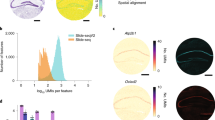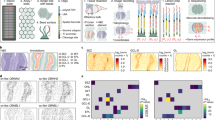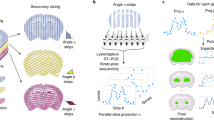Abstract
Capture array-based spatial transcriptomics methods have been widely used to resolve gene expression in tissues; however, their spatial resolution is limited by the density of the array. Here we present expansion spatial transcriptomics to overcome this limitation by clearing and expanding tissue prior to capturing the entire polyadenylated transcriptome with an enhanced protocol. This approach enables us to achieve higher spatial resolution while retaining high library quality, which we demonstrate using mouse brain samples.
This is a preview of subscription content, access via your institution
Access options
Access Nature and 54 other Nature Portfolio journals
Get Nature+, our best-value online-access subscription
$29.99 / 30 days
cancel any time
Subscribe to this journal
Receive 12 print issues and online access
$259.00 per year
only $21.58 per issue
Buy this article
- Purchase on Springer Link
- Instant access to full article PDF
Prices may be subject to local taxes which are calculated during checkout


Similar content being viewed by others
Data availability
Mouse brain section containing the hippocampus region is a publicly available dataset that can be found (along with the mouse reference genome mm10) on the 10x Genomics website (https://www.10xgenomics.com/resources/datasets/mouse-brain-section-coronal-1-standard-1-0-0). The single-cell RNA-seq dataset of mouse brain can be downloaded online (http://mousebrain.org/adolescent/downloads.html). Mouse olfactory bulb (MOB) bulk RNA-seq and Slide-seq datasets used for comparison were obtained from refs. 11,12. All data generated in this study (standard Visium data on MOB, all Ex-ST data and Visium data generated using the modified protocol) including space ranger output files, stereoscope output files, DAPI and bright field images are available at the Mendeley repository26. Raw sequence data can be found at the NCBI BioProject with the accession number PRJNA957091. Source data are provided with this paper.
Code availability
The code used for data analysis and generating figures is available at https://github.com/fyh1221/Expansion_Spatial_Transcriptomics.
References
Larsson, L., Frisén, J. & Lundeberg, J. Spatially resolved transcriptomics adds a new dimension to genomics. Nat. Methods 18, 15–18 (2021).
Rao, A., Barkley, D., França, G. S. & Yanai, I. Exploring tissue architecture using spatial transcriptomics. Nature 596, 211–220 (2021).
Moses, L. & Pachter, L. Museum of spatial transcriptomics. Nat. Methods 19, 534–546 (2022).
Ståhl, P. L. et al. Visualization and analysis of gene expression in tissue sections by spatial transcriptomics. Science 353, 78–82 (2016).
Asp, M. et al. A spatiotemporal organ-wide gene expression and cell atlas of the developing human heart. Cell 179, 1647–1660 (2019).
Lewis, S. M. et al. Spatial omics and multiplexed imaging to explore cancer biology. Nat. Methods 18, 997–1012 (2021).
Maniatis, S. et al. Spatiotemporal dynamics of molecular pathology in amyotrophic lateral sclerosis. Science 364, 89–93 (2019).
Wassie, A. T., Zhao, Y. & Boyden, E. S. Expansion microscopy: principles and uses in biological research. Nat. Methods 16, 33–41 (2019).
Tepe, B. et al. Single-cell RNA-seq of mouse olfactory bulb reveals cellular heterogeneity and activity-dependent molecular census of adult-born neurons. Cell Rep. 25, 2689–2703 (2018).
Allen Institute for Brain Science. Allen Mouse Brain Atlas. mouse.brain-map.org (2004).
Endo, F. et al. Molecular basis of astrocyte diversity and morphology across the CNS in health and disease. Science 378, eadc9020 (2022).
Rodriques, S. G. et al. Slide-seq: a scalable technology for measuring genome-wide expression at high spatial resolution. Science 363, 1463–1467 (2019).
Andersson, A. et al. Single-cell and spatial transcriptomics enables probabilistic inference of cell type topography. Commun. Biol. 3, 565 (2020).
Ressler, K. J., Sullivan, S. L. & Buck, L. B. Information coding in the olfactory system: evidence for a stereotyped and highly organized epitope map in the olfactory bulb. Cell 79, 1245–1255 (1994).
Vassar, R. et al. Topographic organization of sensory projections to the olfactory bulb. Cell 79, 981–991 (1994).
Zeisel, A. et al. Molecular architecture of the mouse nervous system. Cell 174, 999–1014 (2018).
Kosik, K. S. Life at low copy number: how dendrites manage with so few mRNAs. Neuron 92, 1168–1180 (2016).
Stickels, R. R. et al. Highly sensitive spatial transcriptomics at near-cellular resolution with Slide-seqV2. Nat. Biotechnol. 39, 313–319 (2021).
Tushev, G. et al. Alternative 3′ UTRs modify the localization, regulatory potential, stability, and plasticity of mRNAs in neuronal compartments. Neuron 98, 495–511 (2018).
Ainsley, J. A., Drane, L., Jacobs, J., Kittelberger, K. A. & Reijmers, L. G. Functionally diverse dendritic mRNAs rapidly associate with ribosomes following a novel experience. Nat. Commun. 5, 4510 (2014).
Chen, A. et al. Spatiotemporal transcriptomic atlas of mouse organogenesis using DNA nanoball-patterned arrays. Cell 185, 1777–1792 (2022).
Zhu, K. W. et al. Decoding the olfactory map through targeted transcriptomics links murine olfactory receptors to glomeruli. Nat. Commun. 13, 5137 (2022).
Moffitt, J. R. et al. High-performance multiplexed fluorescence in situ hybridization in culture and tissue with matrix imprinting and clearing. Proc. Natl Acad. Sci. USA 113, 14456–14461 (2016).
Fan, Y. et al. Mechanical expansion microscopy. Methods Cell Biol. 161, 125–146 (2021).
Tarashansky, A. J., Xue, Y., Li, P., Quake, S. R. & Wang, B. Self-assembling manifolds in single-cell RNA sequencing data. eLife 8, e48994 (2019).
Andrusivova, Z. & Fan, Y. Ex-ST, Mendeley Data, v1, https://doi.org/10.17632/nrbsxrk9mp.1
Acknowledgements
We thank Y. Lim, J. Gibson and Z. Zeng for critical discussions, and K. Zhu and H. Matsunami for sharing the data to validate the mapped glomeruli positions. Y.F. is a Bio-X Stanford Interdisciplinary Graduate Fellow. C.C. is supported by an NSF Graduate Research Fellowship and a Stanford Graduate Fellowship. B.W. is a Beckman Young Investigator. This work is supported by an National Institutes of Health grant (1R35GM138061) to B.W., the Neuro-omics project of Wu Tsai Big Ideas in Neuroscience program to L.Lu. and B.W., the European Research Council (ERC) under the European Union’s Horizon 2020 research and innovation program (grant agreement no. 101021019) to J.L., and a Swedish Research Council grant to J.L.
Author information
Authors and Affiliations
Contributions
Y.F., Ž.A., J.L. and B.W. initiated and designed the project; Y.F., Ž.A., Y.W. and C.C. performed the experiments; Y.F. and Ž.A. analyzed the data with assistance from Y.W., L.La. and M.H.; Y.F., Ž.A. and B.W. wrote the paper with input from all of the other authors; L.Lu., J.L. and B.W. provided supervision and guidance.
Corresponding authors
Ethics declarations
Competing interests
Ž.A., L.La., M.H. and J.L. are scientific consultants for 10x Genomics, which holds intellectual property rights to the spatial transcriptomics technology. The other authors declare no competing interests.
Peer review
Peer review information
Nature Methods thanks Iwijn De Vlaminck, Chenglong Xia, and the other, anonymous, reviewer(s) for their contribution to the peer review of this work. Peer reviewer reports are available. Primary Handling Editor: Rita Strack, in collaboration with the Nature Methods team.
Additional information
Publisher’s note Springer Nature remains neutral with regard to jurisdictional claims in published maps and institutional affiliations.
Extended data
Extended Data Fig. 1 RNA release and capture.
a, The workflow to identify the optimal release temperature. Gel with anchored transcripts was heated for 30 min at different temperatures to release RNA molecules, which were collected and quantified on a Bioanalyzer. b, Representative bioanalyzer gel image from three replicates, showing RNA released from the gel at different incubation temperatures. c, Representative bioanalyzer traces showing the released RNA. Only weak rRNA peaks are expected as the RNA anchoring is mediated by polyA. d, Released RNA concentrations at different incubation temperatures measured from three biological replicates. Error bars: mean ± standard derivation (SD). Increasing temperature from 39 °C to 41 °C significantly increased RNA concentrations, whereas no significant difference was observed above 41 °C. P values: two-sided Welch’s t-test. e, Violin plot showing the number of UMIs per gene detected by Ex-ST and Visium using standard and modified protocols. f-g, Comparisons of number of genes (f) and UMIs (g) per tissue area (20 by 20 µm) measured by Ex-ST and Visium using the standard and modified protocols, calculated by normalizing the number of genes and UMIs per spot by the tissue area covering each spot. Ex-ST and standard Visium data in e-g were downsampled to match sequencing saturation (Extended Data Table 1). P values: two-sided, two-sample Mann-Whitney-Wilcoxon tests.
Extended Data Fig. 2 Ex-ST captures RNA with limited biases.
a, Comparison of the number of UMIs per gene between two Ex-ST MOB replicates. b-d, Comparisons of the number of UMIs per gene detected in the Ex-ST and standard Visium MOB datasets (b), in the Ex-ST and bulk RNA-seq MOB datasets (c) and in the Ex-ST and Slide-seq hippocampus datasets (d). Red lines: least squares linear fit. e, Pie charts showing RNA biotypes captured by Ex-ST and Visium using standard and modified protocols from MOB samples. Proportions are quantified by the total UMI counts of each biotype. f, Gene body coverage for the Ex-ST and standard/modified Visium MOB data. g, Bioanalyzer traces of cDNA from MOB samples before the fragmentation step for the Ex-ST and standard/modified Visium protocols. h, Ratio of exonic and intronic reads in the Ex-ST and standard/modified Visium MOB data.
Extended Data Fig. 3 Annotation of spatial clusters of the MOB Ex-ST data.
a, The expression of region-specific marker genes detected by ISH, obtained from Allen Brain Atlas10. b, Comparison of number of UMIs of select region-specific marker genes measured by Ex-ST and standard Visium from matched tissue areas. Bar charts: mean of two replicates. c, UMAP showing Ex-ST MOB clusters identified by unsupervised clustering, colored by cluster annotation. d, Marker gene expression overlaid on the UMAP visualization. e, Dot plot showing top marker genes for each cluster.
Extended Data Fig. 4 Cell type compositions of spots in the MOB datasets.
a, Density plot showing the distribution of dominating cell type occupancy at each spot for Ex-ST and Visium using standard and modified protocols. b, Cell type occupancy of each spot in the modified Visium data visualized for two cell types, OB neuroblasts and M/T cells. c, Comparison of cell type composition at individual spots in the Ex-ST, standard Visium, and modified Visium datasets visualized for two cell types, inner horizontal cells located in GCL and ensheathing cells in ONL.
Extended Data Fig. 5 Characterization of the Ex-ST mouse hippocampus data.
a, UMAP showing the annotated clusters identified by unsupervised clustering of the Ex-ST hippocampus data. b, Dot plot showing the top marker genes of each cluster. c, Spatial gene expression of region-specific marker genes measured by Ex-ST, that is, Wfs for CA1, Rgs14 for CA2, Chgb for CA3, Dgkh for DG. d, Comparison of the number UMIs per gene between the Ex-ST replicates. e, Comparison of the number of UMIs per gene in the Ex-ST and standard Visium datasets. f, Pie charts showing RNA biotype composition in the Ex-ST and standard Visium data. Proportions are quantified by the UMI counts of each biotype. g, Gene body coverage of the Ex-ST and standard Visium data. h, Ratio of exonic and intronic reads in the Ex-ST and standard Visium datasets.
Extended Data Fig. 6 Ex-ST hippocampal data has higher spatial resolution compared to standard Visium.
a, Cell type composition of individual spots in the Ex-ST data downsampled to match the sequencing saturation of the 10x Genomics dataset. Three major neuronal cell types are shown. Note that the patterns are almost identical to Fig. 2b, suggesting that cell type devolution is mostly insensitive to sequencing depth in the regime of 60–90% saturation. b, Comparison of ISH (top), obtained from Allen Brain Atlas10, normalized spatial expression of oligodendrocyte marker genes detected by Ex-ST (middle) and standard Visium (bottom). c, Cell type composition of individual spots in Ex-ST downsampled to match the sequencing saturation of the 10x Genomics data. Oligodendrocyte subclasses are shown, with patterns identical to Fig. 2e. d, Comparison of normalized spatial distribution of low-expression dendrite-enriched transcripts between Ex-ST and standard Visium. Note the lack of pattern in the standard Visium data.
Supplementary information
Source data
Source Data Extended Data Fig. 1
Source data used for statistics.
Source Data Extended Data Fig. 2
Source data used for statistics.
Source Data Extended Data Fig. 3
Source data used for statistics.
Source Data Extended Data Fig. 5
Source data used for statistics.
Rights and permissions
Springer Nature or its licensor (e.g. a society or other partner) holds exclusive rights to this article under a publishing agreement with the author(s) or other rightsholder(s); author self-archiving of the accepted manuscript version of this article is solely governed by the terms of such publishing agreement and applicable law.
About this article
Cite this article
Fan, Y., Andrusivová, Ž., Wu, Y. et al. Expansion spatial transcriptomics. Nat Methods 20, 1179–1182 (2023). https://doi.org/10.1038/s41592-023-01911-1
Received:
Accepted:
Published:
Issue Date:
DOI: https://doi.org/10.1038/s41592-023-01911-1
This article is cited by
-
Spatial multi-omics: novel tools to study the complexity of cardiovascular diseases
Genome Medicine (2024)
-
scButterfly: a versatile single-cell cross-modality translation method via dual-aligned variational autoencoders
Nature Communications (2024)
-
Decoder-seq enhances mRNA capture efficiency in spatial RNA sequencing
Nature Biotechnology (2024)



